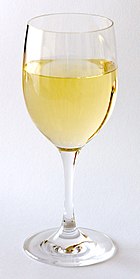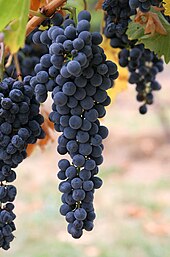His

Wine is an alcoholic beverage, typically made of fermented grape juice.[1] The natural chemical balance of grapes is such that they can ferment without the addition of sugars, acids, enzymes or other nutrients.[2] Wine is produced by fermenting crushed grapes using various types of yeast. Yeast consumes the sugars found in the grapes and converts them into alcohol. Different varieties of grapes and strains of yeasts are used depending on the type of wine being produced.[3]
Although other fruits such as apples and berries can also be fermented, the resultant wines are normally named after the fruit from which they are produced (for example, apple wine or elderberry wine) and are generically known as fruit wine or country wine (not to be confused with the French term vin de pays). Others, such as barley wine and rice wine (i.e., sake), are made from starch-based materials and resemble beer and spirit more than wine, while ginger wine is fortified with brandy. In these cases, the use of the term "wine" is a reference to the higher alcohol content, rather than production process.[4] The commercial use of the English word "wine" (and its equivalent in other languages) is protected by law in many jurisdictions.[5]
Wine has a rich history dating back to around 6000 BC and is thought to have originated in areas now within the borders of Georgia and Iran.[6][7] Wine first appeared in Europe at about 4500 BC in the Balkans, and was very common in ancient Greece, Thrace and Rome. Wine has also played an important role in religion throughout history. The Greek god Dionysus and the Roman equivalent Bacchus represented wine, and the drink is also used in Catholic Eucharist ceremonies and the Jewish Kiddush.
The word "wine" comes from the Proto-Germanic "*winam," an early borrowing from the Latin vinum, "wine" or "(grape) vine," itself derived from the Proto-Indo-European stem *win-o- (cf. Hittite: wiyana, Lycian: Oino, Ancient Greek οῖνος - oînos, Aeolic Greek ϝοίνος - woinos).[8][9] The earliest attested terms referring to wine are the Mycenaean Greek me-tu-wo ne-wo meaning "the month of new wine" or "festival of the new wine" and wo-no-wa-ti-si meaning "wine garden", writtentory
Archaeological evidence suggests that the earliest known production of wine, made by fermenting grapes, took place in sites in Georgia and Iran, from as early as 6000 BC.[6][7] These locations are all within the natural area of the European grapevine Vitis vinifera.
A 2003 report by archaeologists indicates a possibility that grapes were used together with rice to produce mixed fermented beverages in China in the early years of 7000 BC. Pottery jars from the Neolithic site of Jiahu, Henan were found to contain traces of tartaric acid and other organic compounds commonly found in wine. However, other fruits indigenous to the region, such as hawthorn, could not be ruled out.[14][15] If these beverages, which seem to be the precursors of rice wine, included grapes rather than other fruits, these grapes were of any of the several dozen indigenous wild species of grape in China, rather than from Vitis vinifera, which were introduced into China some 6000 years later.[14]
The oldest known evidence of wine production in Europe is dated to 4500 BC and comes from archaeological sites in Greece.[16][17] The same sites also contain the world’s earliest evidence of crushed grapes.[16] Literary references to wine are abundant in Homer (9th century BC, but possibly composed even earlier), Alkman (7th century BC), and others. In Ancient Egypt, six of 36 wine amphoras were found in the tomb of King Tutankhamun bearing the name "Kha'y", a royal chief vintner. Five of these amphoras were designated as from the King's personal estate with the sixth listed as from the estate of the royal house of Aten.[18] Traces of wine have also been found in central Asian Xinjiang, dating from the second and first millennia BC.[19]
In medieval Europe, the Roman Catholic Church was a staunch supporter of wine since it was necessary for the celebration of Mass. Monks in France made wine for years, storing it underground in caves to age.[20] There is an old English recipe which survived in various forms until the nineteenth century for refining white wine using Bastard—bad or tainted bastardo wine.[21]
Classification
Regulations govern the classification and sale of wine in many regions of the world. European wines tend to be classified by region (e.g. Bordeaux and Chianti), while non-European wines are most often classified by grape (e.g. Pinot Noir and Merlot). More and more, however, market recognition of particular regions is leading to their increased prominence on non-European wine labels. Examples of non-European recognized locales include Napa Valley in California, Willamette Valley in Oregon, Columbia Valley in Washington, Barossa Valley and Hunter Valley in Australia, Central Valley in Chile, Vale dos Vinhedos in Brazil, Hawke's Bay and Marlborough in New Zealand, Okanagan Valley and Niagara Peninsula in Canada.
Some blended wine names are marketing terms, and the use of these names is governed by trademark law rather than by specific wine laws. For example, Meritage (sounds like "heritage") is generally a Bordeaux-style blend of Cabernet Sauvignon and Merlot, and may also include Cabernet Franc, Petit Verdot, and Malbec. Commercial use of the term "Meritage" is allowed only via licensing agreements with an organization called the "Meritage Association".











0 comments:
Post a Comment